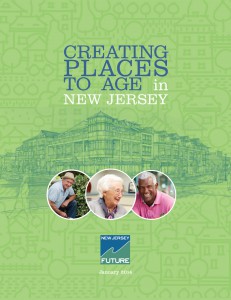Creating Places To Age in New Jersey
There is a significant mismatch in New Jersey between where large numbers of older residents live and which municipalities are most prepared, from a land-use perspective, to accommodate them.
This report presents a methodology for characterizing municipalities’ “aging-friendliness” based on four features of their land-use patterns:
- The number of destinations per square mile – a higher number is better because it makes it easier for people of all ages to accomplish daily tasks efficiently;
- The presence of a mixed-use “downtown,” fostering not just a high number but a greater variety of destinations in close proximity;
- The existence of a well-connected local street network, allowing for walking and more direct access to destinations; and
- Access to public transportation, particularly local buses, enabling greater mobility for those who don’t drive.
All of these design characteristics are important determinants of how easy or difficult it will be for older residents, who may be facing mobility challenges, to accomplish their daily needs without having to drive long distances on busy regional roads.
Statewide, almost 300,000 people aged 55 and older, or approximately 13 percent of all older residents in New Jersey, live in areas that scored low on all four of the report’s age-friendliness indicators. Among the 109 municipalities that scored poorly on all four characteristics, some are host to notably large populations of people 55 and older. For example, Tinton Falls and Wall Township in Monmouth County and Monroe Township in Middlesex County together contain more than 30,000 residents over the age of 55. And on the other end of the spectrum, some municipalities that score well on all four measures are missing opportunities to host more older residents: Jersey City, Hoboken, Princeton, and New Brunswick all have over-55 populations that make up less than 20 percent of their totals, compared to a statewide population that is 25 percent 55 and older.
A supplement to the report examines municipalities in Bergen and Passaic counties in greater detail, looking at factors such as housing type, size, affordability and safety. A companion piece, a best practices guide for municipalities, offers recommendations on how to make communities more “aging-friendly.” An online appendix will list every municipality and its ranking on each of the four indicators, along with updated Census data about its older population.
The conclusions of the report are clear: As New Jersey’s population ages, many residents will find themselves living in areas that are not well equipped to accommodate their changing needs. Those people not able to relocate will face the possibility of increasing social isolation and need for assistance. For those low-scoring municipalities that want to retain their residents as they grow older, doing nothing will not be an option.
Download:
Creating Places To Age in New Jersey (PDF)
Bergen/Passaic supplement (PDF)
Municipal Best Practices (PDF)
Table of all municipalities and their rankings (PDF)












